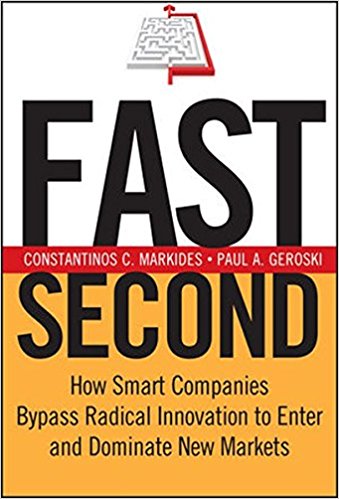The Business of Biom* - Part 1
ISO/TC 266 wants to engage business and industry to better understand how biom* could make a more significant impact. One of the challenges is that we tend to speak the language of biology, rather than the language of business. How does business go about innovating?
 A colleague on the ISO/TC 279 Information Management project suggested Fast Second: How Smart Companies Bypass Radical Innovation to Enter and Dominate New Markets by Markides and Geroski. This book describes the lifecycle of disruptive innovations:
A colleague on the ISO/TC 279 Information Management project suggested Fast Second: How Smart Companies Bypass Radical Innovation to Enter and Dominate New Markets by Markides and Geroski. This book describes the lifecycle of disruptive innovations:
- Development of a new technological discovery or principle (usually in academic research or labs).
- Market exploration/creation by entrepreneurs/startups (understand technology, create wide variety of products, identify target clients).
- Market consolidation, typically by large companies that have the required production, delivery and support capabilities (develop and promote a dominant design).
- Market expansion through strategic innovation (block competitors from grabbing market share).
A recent example is artificial intelligence. The underlying principles of modern AI were initially explored in the 1960s through the 1980s, but fell from favor in the latter part of the 20th century due to the limitations of current hardware and software. The market exploration phase restarted early in the 21st century, driven by the availability of significantly more powerful hardware and ‘deep learning’ algorithms. Numerous players sprung up hoping to grab market share. Recently, large technology companies are beginning to consolidate the ‘big data’ markets, with some of them already exploring strategies for broadening market penetration through lowering barriers to client access.
Fast Second suggests that most disruptive innovations are 'supply-push', and therefore relevant to biom* innovations that follow the 'biology to design' pathway. A few biom* examples come to mind. Self-cleaning surfaces (such as the Lotus Effect and SLIPs) as well as structural color have led to various products trying to enter a range of market niches, including Lotusan®, Sharlet, and Mirasol. Velcro® is one of the few biomimetic innovations that has reached the consolidation/expansion phases, possibly because the ‘dominant design’ emerged early in the process.
Given that biom* promotes its disruptive potential, it would be worthwhile exploring the lifecycle of biom* innovation. Are biom* concepts not sufficiently developed or generalized so that entrepreneurs can built startups around them? Are there gaps in the supporting components, methods and tools required for market success, similar to what happened in the early days of AI? Are biom* innovations perceived as too different/risky? Are the market potentials unclear? Stories from the Trenches of Biomimetic Innovation: Ideation and Proof of Concept in ZQ21 is the first in a series of articles following four biom* case studies from ideation through to commercialization.
What do you think?
- nhoeller's blog
- Login or register to post comments

Comments
Biom* and Entrepreneurs
Fast Second proposes that innovative ideas go through a period of entrepreneurial pioneering that explores potential market niches. Blockchains are a recent example, not only in terms of cryptocurrencies but also a broad range of applications from tracking fish to managing health records. This kind of entrepreneurial interest seems rare in biom* - the only two examples that come to mind are the Lotus Effect and products inspired by gecko adhesion. In both cases, the innovations are often described through the underlying principles (wetting angles, van der Waals forces). In addition, implementation details are known, lowering the barriers to entry and the perceived risk.
In contrast, A fracture-resistant cement could make mile-high skyscrapers possible emphasises the biological inspiration (sea urchin spines), describes a composite of hard materials in an elastic matrix, and proposes a rather ambitious application. On the surface, the underlying principle seems related to the structure of abalone shells, where a polymer matrix blocks the propagation of cracks forming in the hard calcite, but the connection is not explicitly made. Entrepreneurs reading the referenced paper will not be enlightened - it seemed very narrow and referenced other papers in terms of the sea urchin connection.
Entrepreneurs bitten by the biom* bug may be motivated to follow biom* developments, although I suspect that many will struggle to find tangible opportunities to apply biom*. Other entrepreneurs will be looking for ideas that have matured to the point where they can identify compelling applications where the risk is acceptable. Communicating biom* advances using engineering language in a broader innovation context and including realistic business applications will help increase the likelihood entrepreneurs will focus on biom* opportunities.